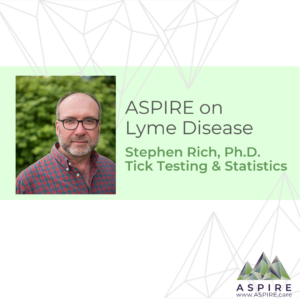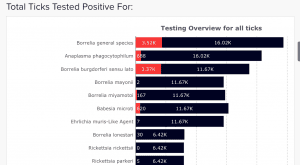Tick Testing and Disease Transmission Statistics
 Gabriella: Thank you to Dr. Rich for talking with ASPIRE today about Tick Report and his lab at U Mass. Dr. Rich and I spoke in 2019 at the Central Mass Lyme Conference. Please tell our ASPIRE community about your work.
Gabriella: Thank you to Dr. Rich for talking with ASPIRE today about Tick Report and his lab at U Mass. Dr. Rich and I spoke in 2019 at the Central Mass Lyme Conference. Please tell our ASPIRE community about your work.
Stephen: TickReport is a service offered by my lab here at the University of Massachusetts. We evaluate the risk that human-biting ticks pose to individuals and populations of people and companion animals. We measure risk by assessing the degree to which a tick poses a threat of exposure to tick-borne pathogens. Specifically, we determine whether the tick is of a species associated with disease transmission, estimate how long the tick has fed, and test whether that tick is infected with one of 20+ germs. We provide this service for individuals, but the aggregated data provide a passive surveillance network that can guide decision making even for those who elect not to subscribe to our service and/or failed to find the tick that bit them.
Gabriella: How does someone send in a tick? Does it have to be a new tick? And how long does it take to get results?
Stephen: Anyone can send us any tick at any time. We use the polymerase chain reaction to detect DNA or RNA of the germs. This method is very accurate and can work with virtually any tick specimen (even those that have been lying around for a very long time). To send us a tick, start by going to our web page to place your order Tick Report. Instructions are provided on that web page to walk you through each step of the process.
Gabriella: Do you test ticks from across the country or just the Northeast?
Stephen: We have received ticks from all 50 states (and even beyond our borders). To see who submits ticks to us, visit our stats page.
Gabriella: Can people send in all stages of ticks to you? Larvae, Nymph, or Adult? Which stage is positive most often for a tick-borne illness
Stephen: We test any stage. For Lyme, Adult ticks are generally the most frequently infected (~50%), followed by nymphs (~25-30%). Larvae are rarely infected with Lyme Borrelia, unless they become infected by the person they are feeding on. This is referred to as a xenodiagnoses and researchers at Tufts have shown that larval tick infection can be used to detect infection.
Gabriella: Is there a “tick season”?
Stephen: There are tick seasonS. Deer ticks, in particular, have a two-year life cycle with active adult periods in April-May and Oct-Dec, while the nymphs are most abundant in May-June. August and September are active times for larval deer ticks. Other species of ticks have different activity periods. Visit our partners at Tick Encounter to learn more.
Gabriella: Are there other tick-borne infections that concern you?
Stephen: There are more than 20 pathogens we test. Lyme is by far the most common, but it’s not the only one. Again, our stats page will tell you what kind of ticks are biting at what time of year and what pathogens are associated with those bites. Tick Report Stats.

Gabriella: What is the percentage of multiple pathogens in one tick?
Stephen: It varies from place to place. We’ve found ticks with 4 or more pathogens in a single tick!
Gabriella: Where on the body are ticks found the most?
Stephen: Many ticks sent to us were found (in order of decreasing frequency) on the upper leg, middle of the back, and above the hairline.
Gabriella: Say someone sends in multiple ticks from their back yard, collected over a week’s time and they come back negative for Lyme, is it safe to assume that ticks collected later in the year in the same yard will be Lyme negative too?
Stephen: With infection rates of 25-50% where ever deer ticks are found, its very unlikely that a sample of even three ticks would all be negative. And if that was the case, its most certainly a sampling effect and should not be interpreted to mean that Lyme is absent.
Gabriella: You mentioned at the Central Mass Lyme conference that none of the ticks you test come back positive for Bartonella henselae, why do you think that is?
Stephen: Quite simply because there is no strong evidence to support the idea that ticks vector Bartonella henselae. And our tests are very specific for the pathogen Bartonella henselae. We are aware that other labs report finding Bartonella in ticks, but since those labs reveal little information about their methods, we cannot interpret their discrepancy. We suspect they are detecting some other Bartonella (which may or may not be a pathogen) or there may be some other (more discouraging) reasons.
Gabriella: What does your data show about which areas have the highest risk of encountering ticks? Woods, fields, back yards?
Stephen: Ticks can be found in edge habitats. Where the forest meets the yard (and lots of leaf litter), you will find ticks. Not so much in the grass (especially well-kept lawns).
Gabriella: Are there ways we can interrupt the tick life cycle to decrease the number of ticks and the incidence of Lyme disease?
Stephen: If you mean, interrupt the life cycle in a way that will substantially reduce the density of ticks in the wild, then I would say not really. Extreme reduction of deer herd may have some effect, but it’s likely to be at a drastic rate that is not practical (or socially acceptable). Perimeter spraying may create barriers to ticks but isn’t likely to reduce their numbers in long term nor overbroad expanses.
But you can interfere with the life cycle of a tick on yourself by making efforts to do tick check (pluck them off) and/or wearing permethrin-treated clothing. Permethrin is safe to humans and deadly to ticks. It will reduce ticks on YOU, but since we are probably not ecologically important hosts, it’s not going to even make a dent in tick populations.
Tick Report and Laboratory of Medical Zoology
Stephen Rich, PhD
Organismic & Evolutionary Biology, University of California Irvine, 1997
Full Biography
Tick Testing Resources
ASPIRE does not endorse or recommend a specific lab. Some states offer tick testing at a limited scope; some only identify tick for tracking purposes. Lyme Disease Association has a more comprehensive list.
- Tick Report – Umass Interview and Data from this article were done by Tick Report.
- TickChek LLC
- Ticknology
- Tick Tests


